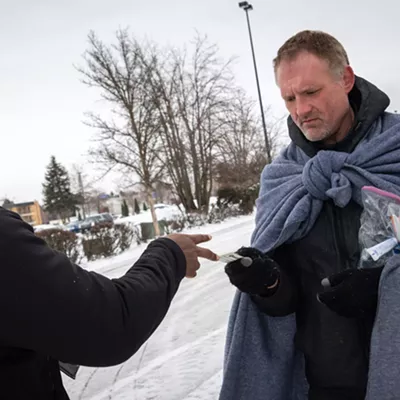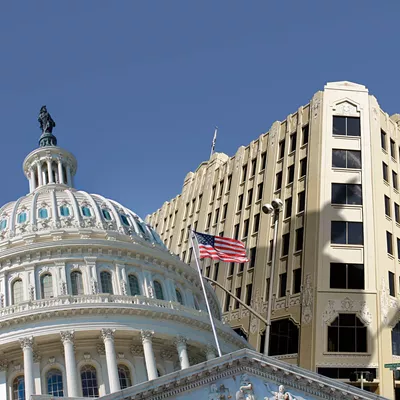
Of all the proposed solutions to Spokane County's emergency shortage of houses, one is glaringly obvious: build more houses.
That's exactly what Realtor Jack Kestell says he's been trying to do. He's representing the owners of an undeveloped piece of property in western Spokane County. Either by selling the land or developing it themselves, he says, the general hope is to build 325 single-family homes and 180 units of multifamily housing, along with a lot of dedicated retail and office space. Part of the property would be dedicated to the Cheney School District, Kestell says.
Right now, however, it's just 180 acres of empty fields behind the Shamrock Paving Company building near the Northern Quest Resort & Casino. But it's also near Airway Heights, where Fairchild Air Force Base personnel and Amazon warehouse workers have been in desperate need of housing.
"That would take a huge weight off of the supply issue," Kestell says. "We're in the middle of the worst housing crisis we've ever had in Spokane County."
Not only has the development not been built, construction hasn't begun, and the zoning hasn't changed to make such a proposed development possible.
In fact, it's been 3½ years, Kestell says, and he hasn't even been able to get approval to change the underlying regional planning borders required to legally change the zoning to build a housing development on that land.
"We've just been blocked by government," Kestell says. "We're trying to figure out how to satisfy them."
Unless that change happens, the most housing anyone could build on the 180-acre property is 18 houses. It all goes back to the state-level restrictions put in place decades ago to try to limit sprawl and plan for development in a way that wouldn't destroy the budgets of local governments.
Dave Andersen, director of the growth management program for the Washington state Department of Commerce, says one goal of these "urban growth area" restrictions is ultimately to save communities money through regionwide planning.
"If your infrastructure is too expensive, then, you know, the community you're building on top of that is ultimately going to be unaffordable," Andersen says.
But Kestell and other critics see those restrictions as yet more hurdles preventing development from happening — and blame that for making a community unaffordable, too.
"It used to be... if you had a piece of property, and you could provide utilities and streets, you could develop it," Kestell says. "That's why we had plenty of housing through the years. But then that just all kind of died about 20 years ago."
Way back in 1990, Washington state passed the Growth Management Act, intending to push denser development inward and limit suburban sprawl. Cities and counties were required to establish urban growth areas — zones in and around each city that were already near a lot of urban infrastructure, like roads, sewer pipes and electric lines.
Want to build an apartment, or even a suburban housing development? It has to be inside the urban growth area.
"The Growth Management Act is the dumbest thing," Kestell says. "It was basically inverse condemnation. They just changed the rules and took away people's property rights."
County Commissioner Al French similarly argues that urban growth area regulations have backfired, suffocating local construction of housing while driving sprawl anyway — the sprawl happened, but just across the border in Kootenai County.
Spokane County's plan for the Airway Heights parcel was simple: Remove roughly 180 acres of the urban growth area map covering the county's off-road vehicle park — which was never going to be used for development — and carve out 180 additional acres on the map to add the property Kestell wants developed.
"It's a net-zero increase in the UGA," French says.
But it's not that simple. Back in 2016, Spokane County settled more than a decade of lawsuits over various county decisions to expand its urban growth area. Part of the deal limited the county's ability to add to the UGA for another decade. Even swaps that didn't increase the area of the UGA came with a catch — the county would have to provide an extensive analysis of the impacts on transportation and capital facilities such as water service, schools and local utilities, identifying funding sources to bring those online.
Both the Department of Commerce and Futurewise — the statewide anti-sprawl group that was part of the county settlement — have insisted that that kind of extensive analysis be conducted, in detail, and they concluded that the limited analysis Kestell did provide was inadequate.
"We're concerned about sewer, we're concerned about stormwater, we're concerned about fire protection and police protection," says Tim Trohimovich, attorney for Futurewise. The property is not even inside the water service area for the city of Spokane, he says — and even after Kestell modified the plans, he's concerned it's too close to Fairchild Air Force Base.
But Kestell says all the analysis requirements put the land's owners in a bind — there's no guarantee that, if they spend a ton of money preparing reports with all the analysis, that Futurewise and the Department of Commerce will be willing to sign off on it.
"The owners aren't willing to spend hundreds of thousands of dollars to do something speculative," Kestell says.
Wrap development in too much red tape, and you make housing expensive. And since housing is one of the best ways to build wealth — the more expensive housing is, the harder it is for anyone to escape poverty.
"When you restrict the amount of housing, who suffers?" French says. "Low-income communities of color."
Back when the county's urban growth area was assessed in 2001, French says, Spokane city officials believed the city's population would grow by 54,000 people in the two decades after 2001 — but in reality, it grew significantly slower.
"The Department of Commerce is supposed to be the watchdog over compliance with the Growth Management Act, and they have let the city slide for the last 20 years," French says.
Trohimovich argues that the problem was that the county created too much land in the unincorporated county to be able to be developed.
"The county has an oversized urban growth area," Trohimovich says. "People are going there because it's cheaper, instead of building in the city of Spokane."
Trohimovich says Futurewise has pushed for reforms to the Growth Management Act, requiring cities to also consider the consequences of not having enough housing built in a region.
Meanwhile, in his attempt to get the UGA boundary changed, Kestell has had to work with Futurewise, the Cheney School District, Fairchild Air Force Base, Spokane County, the cities of Spokane and Airway Heights, and the Washington state departments of Commerce and Transportation.
But while that takes a lot of time up front, the Department of Commerce's Andersen says it ultimately makes things easier rather than needing to fight about each individual development.
"I don't think the statute necessarily is broken, but it's still difficult," Andersen says about the Growth Management Act. "You're still talking about getting a lot of people to work together. It makes it look harder, because you can't ignore each other."
Poor infrastructure planning can sabotage whole swaths of developable land in the county — French, in fact, points out that the city of Spokane's failure to build a road for local traffic next to U.S. 195 has paralyzed whole swaths of developable land in the region.
But no matter where homes are built, French argues, Spokane hasn't built nearly enough housing — we're 32,000 homes short. You'd have to have to build a development like Kestell wants to build 64 times to catch up. ♦
























